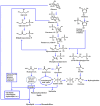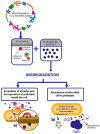Natural surfactant mediated bioremediation approaches for contaminated soil
- PMID: 37859781
- PMCID: PMC10583161
- DOI: 10.1039/d3ra05062a
Natural surfactant mediated bioremediation approaches for contaminated soil
Abstract
The treatment of environmental pollution by employing microorganisms is a promising technology, termed bioremediation, which has several advantages over the other established conventional remediation techniques. Consequently, there is an urgent inevitability to develop pragmatic techniques for bioremediation, accompanied by the potency of detoxifying soil environments completely. The bioremediation of contaminated soils has been shown to be an alternative that could be an economically viable way to restore polluted soil. The soil environments have long been extremely polluted by a number of contaminants, like agrochemicals, polyaromatic hydrocarbons, heavy metals, emerging pollutants, etc. In order to achieve a quick remediation overcoming several difficulties the utility of biosurfactants became an excellent advancement and that is why, nowadays, the biosurfactant mediated recovery of soil is a focus of interest to the researcher of the environmental science field specifically. This review provides an outline of the present scenario of soil bioremediation by employing a microbial biosurfactant. In addition to this, a brief account of the pollutants is highlighted along with how they contaminate the soil. Finally, we address the future outlook for bioremediation technologies that can be executed with a superior efficiency to restore a polluted area, even though its practical applicability has been cultivated tremendously over the few decades.
This journal is © The Royal Society of Chemistry.
Conflict of interest statement
The authors declare no competing financial interests.
Figures













Similar articles
-
Biosurfactant is a powerful tool for the bioremediation of heavy metals from contaminated soils.J Hazard Mater. 2021 Sep 15;418:126253. doi: 10.1016/j.jhazmat.2021.126253. Epub 2021 Jun 2. J Hazard Mater. 2021. PMID: 34119972 Review.
-
Genetically engineered microbial remediation of soils co-contaminated by heavy metals and polycyclic aromatic hydrocarbons: Advances and ecological risk assessment.J Environ Manage. 2021 Oct 15;296:113185. doi: 10.1016/j.jenvman.2021.113185. Epub 2021 Jul 6. J Environ Manage. 2021. PMID: 34243092 Review.
-
The Interaction between Plants and Bacteria in the Remediation of Petroleum Hydrocarbons: An Environmental Perspective.Front Microbiol. 2016 Nov 21;7:1836. doi: 10.3389/fmicb.2016.01836. eCollection 2016. Front Microbiol. 2016. PMID: 27917161 Free PMC article. Review.
-
[Interactions among soil biota and their applications in synergistic bioremediation of heavy-metal contaminated soils].Sheng Wu Gong Cheng Xue Bao. 2020 Mar 25;36(3):455-470. doi: 10.13345/j.cjb.190598. Sheng Wu Gong Cheng Xue Bao. 2020. PMID: 32237540 Review. Chinese.
-
Mesocosm-based simulations to optimize a bioremediation strategy for the effective restoration of wildfire-impacted soils contaminated with high-molecular-weight hydrocarbons.J Appl Microbiol. 2021 Sep;131(3):1249-1260. doi: 10.1111/jam.15018. Epub 2021 Feb 10. J Appl Microbiol. 2021. PMID: 33507603
References
-
- Zwolak A. Sarzynska M. Szpyrka E. Stawarczyk K. Sources of Soil Pollution by Heavy Metals and Their Accumulation in Vegetables: A Review. Water, Air, Soil Pollut. 2019;230:164.
-
- Baweja P., Kumar S. and Kumar G., Fertilizers and Pesticides: Their Impact on Soil Health and Environment, in Soil Health. Soil Biology, ed. B. Giri and A. Varma, Springer, Cham, 2020, vol. 59, pp. 265–285
-
- Rodríguez-Eugenio N., McLaughlin M. and Pennock D., Soil Pollution: A Hidden Reality, FAO, Rome, 2018
-
- Mishra S., Bharagava R. N., More N., Yadav A., Zainith S., Mani S. and Chowdhary P., Heavy metal contamination: an alarming threat to environment and human health, in Environmental Biotechnology: For Sustainable Future, ed. R. C. Sobti, N. K. Arora and R. Kothari, Springer Singapore, 2019, pp. 103–125
-
- Aljamali N. M. Jawad A. M. Alabbasy A. J. Salih L. A. M. A Literature Review on Types of Contamination (Biological, Chemical, Medical) IJGC. 2019;5:7–14.
Publication types
LinkOut - more resources
Full Text Sources

